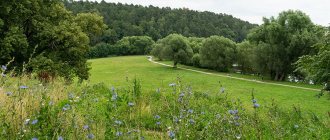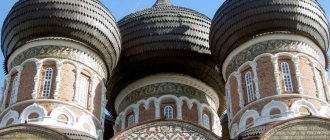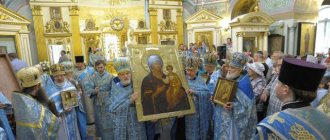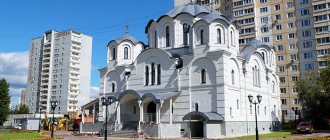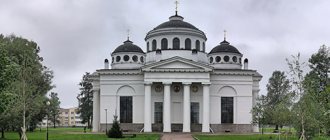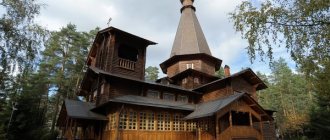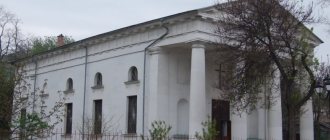Moscow: from cross to cross. Taganka
This time we will make a pilgrimage to Taganka - one of the oldest Moscow districts. There are many ancient temples and monasteries here. Holy Blessed Matrona of Moscow, Venerable Aristoklius of Athos, Hieroconfessor Roman of Moscow - these amazing saints hear us, help and console us, and make sure that as many people as possible turn to God with all their hearts.
— Moscow: from cross to cross
— Moscow: from cross to cross. Iverskaya
Church of the Assumption of the Mother of God in Gonchary. Since 1948, this has been the metochion of the Bulgarian Orthodox Church in Moscow.
Once I had to spend several days on Taganka. I was on a business trip, at a conference that was held a stone's throw from the Taganskaya metro station, and after work for several days in the evenings I simply wandered the streets and alleys - again from cross to cross. And, despite the fact that it was late autumn, these days were remembered as a wonderful warm time of many discoveries.
Now among the churches where I try to visit again whenever possible is the Church of the Assumption of the Mother of God in Gonchary (Goncharnaya, 29). The very external decoration of the temple can tell a lot about its history: the temple is decorated with many colorful tiles. It was built in Goncharnaya Sloboda, which is one of the oldest Moscow districts that emerged towards the end of the 15th century. Craftsmen settled here, and, as was often the case in Rus', each of the craft communities considered it their duty to build their own temple. The ornate stone Assumption Church was erected in 1654. The famous tile maker Stepan Polubes took part in its decoration. The main shrine of the Assumption Church is the miraculous icon “Three Hands” (list made in 1716). Many believe that it was thanks to the intercession of the Mother of God that the temple was never closed. Since 1948, this has been the metochion of the Bulgarian Orthodox Church in Moscow.
The Temple of Martin the Confessor is one of the most striking monuments of classical architecture in Moscow
Another extremely interesting place on Taganka is the majestic temple of Martin the Confessor. If you look on the map, this is the street. A. Solzhenitsyn, 15. However, the address plaque on the wall of the temple itself indicates the historical name of the street: until 1919 it was called Bolshaya Alekseevskaya. Even though today the church and bell tower are somewhat lost among the new buildings, they can be seen from afar. Experts believe that the Church of Martin the Confessor is one of the most striking monuments of classical architecture in Moscow. It was consecrated in 1806. In 1812 it was badly damaged by fire, but it was here that the first thanksgiving service was held after the French left Moscow. It is interesting that the temple has preserved paintings in the picturesque style of the Italian artist A. Claudo.
The main shrine of the Church of Martin the Confessor is an ancient copy of the Georgian Icon of the Mother of God
In Soviet times, there was a film studio, a book depository, and a computer center here. In the early 1990s, the temple was returned to the Church, and long restoration work began. And a real miracle happened: it turned out that in the 1930s, when the temple was closed, someone hid the painting behind thin sheets of plywood, so it has survived to this day unharmed. The historical iconostasis of the temple in the form of a triumphal arch is also preserved in the storerooms of the State Museum of Architecture. A. V. Shchuseva. Despite the fact that the architecture and paintings of this temple are atypical for Moscow (rather, they are characteristic of imperial St. Petersburg), it makes a very big impression.
Its main shrine is the ancient miraculous copy of the Georgian Icon of the Mother of God. Here, in a separate ark, there are shrines associated with the holy blessed Matrona of Moscow: her funeral shirt and belt.
Strength in weakness
Pokrovsky Monastery, where the relics of St. Matrona of Moscow reside
It is from the Taganskaya station that, as a rule, the journey of pilgrims to the Intercession Monastery (Taganskaya, 58) begins, to the relics of this amazing saint. On weekdays and holidays, in summer and winter, there are a huge number of people here. The cases of help through prayers to the blessed Matrona are innumerable. During the years of my church neophyte, it seemed wrong to me that people come to her mainly with their earthly problems and concerns, even those who never go to church. There was even a feeling of a kind of jealousy and hostility towards such “petitioners”, from which I was saved... by the saint herself.
One day in late autumn I found myself in line to see her relics. I started looking around. Only a few people stand nearby with books in their hands, reading a life or an akathist. You can immediately see those who came from afar, or those who came in some kind of need, but they are not the majority. What was surprising was that there were many well-dressed women with luxurious bouquets of flowers nearby, and many young men. Even a foreigner with a translator stood in that line. From the appearance of these people one could not suspect that there were insoluble problems in their lives. Why do they go to Matronushka, why do they stand for several hours in the chilly November wind? But when I thought - why? — somewhere in the depths of my soul the words sounded: “The power of God is made perfect in weakness.”
In fact, if you think about it, who was Matronushka during her lifetime by the standards of today’s world? A helpless disabled person who has never seen sunlight? A homeless, persecuted wanderer? But they come to her for help - both during life, and after death, and before her glorification as a saint, and, of course, now - millions of people who are much more prosperous from an everyday point of view. And she helps, consoles, instructs, and most importantly, leads to the temple, to God...
On weekdays and holidays, in summer and winter, many people come to Matronushka
Next to the saint, you clearly experience inner peace, a desire to pray, reverent spiritual silence and some special warmth come somewhere in the depths of your heart. For me, all this is irrefutable evidence of the truth of the shrine, which will again and again make me strive for it.
One more fact may be important for pilgrims from Saratov. In 1923–1929, the rector of the Intercession Monastery was Archimandrite Veniamin (Milov), the future archpastor, one of the most revered ascetics of the Saratov land. A large Poklonny cross was erected on the territory of the monastery in memory of the deceased brethren.
Getting to the Intercession Monastery is not difficult: from the Taganskaya or Marksistskaya metro stations, which are located on the other side of Taganskaya Square, it’s a 15-minute walk or two stops on any trolleybus running along Taganskaya Street. Near “Marxistskaya”, at a public transport stop, drivers of special minibuses “to Matrona” will beckon you, but using their services is five times more expensive, and I think there is no need for this.
Athos in the center of the capital
Metochion of the Russian Monastery on Mount Athos
No less amazing discoveries can be made if from the exit from the Taganskaya Koltsevaya station you head in the other direction - along Goncharnaya and Nizhnyaya Radishchevskaya streets to the Yauza River. At Goncharnaya, 6 there is a courtyard of the Russian Monastery of St. Panteleimon on Mount Athos. Before the revolution, the Athonite courtyard was located on Bolshaya Polyanka (then the buildings were requisitioned, churches and chapels were destroyed). In 1991, the building of the Church of the Great Martyr Nikita on Shvivaya Hill (1595) was transferred to house the metochion. Today this is also a significant center of pilgrimage: people come here not only to touch Athos and its shrines (there are icons with particles of the relics of the Great Martyr Panteleimon, the Apostle Andrew the First-Called, and the Venerable Silouan of Athos), but also... to visit the venerable elder Aristoclia. They say that many people came to him during his lifetime; the path to his grave at the Danilovsky cemetery was never overgrown in godless times. In 2004, the elder was glorified as a locally revered saint, and recently, in 2016, by decision of the Council of Bishops, his name was included in the calendar for church-wide veneration. While the name of St. Aristoclius is not as well known outside of Moscow as in the capital itself, but believing Muscovites treat him with great love and warmth.
Venerable Elder Aristoclius: “I have no greater concern than to bring you to the Lord”
Hieromonk Aristokliy, in the world Alexey Alekseevich Amvrosiev, was born in Orenburg in 1848. In 1876, he went to Holy Mount Athos and entered the Russian St. Panteleimon Monastery, and in 1880 he was tonsured a monk. For many years he was rector of the metochion in Moscow: from 1891 to 1894 and from 1909 until his death in 1918. People saw that the elder had exceptional spiritual gifts. He received hundreds of visitors every day, visited the sick, and generously helped the poor. There are known cases of amazing healings through the prayers of an elder: a boy born blind, a paralyzed girl. And the main thing is that, having received help, people no longer retreated from the Church, because they saw in the life of the priest a living example of life in Christ. He radiated quiet joy. His words to his spiritual children are known: “I have no greater concern than to lead you to the Lord. And there is no more serious matter on earth than the salvation of the soul. The whole world is not worth one soul working for the Lord.” And today people feel his love and go to the monk with their sorrows or spiritual questions, as if they were alive...
Divine services at the Athos Compound have their own characteristics: Sunday services (all-night vigil and early Liturgy) are celebrated here at night (beginning at 10:30 p.m.). The singing during the service is special, monastic: artless, but very concentrated.
It should be noted that the rules at the Athos courtyard are quite strict. For example, the use of a mobile phone is not allowed throughout the territory; men wearing shorts or women without the traditional skirt and headscarf are not allowed into the temple. Today we have almost lost the habit of such strictness, but here it is perceived as something natural: it is felt that the monks are strict, first of all, with themselves in order to preserve their monastic dispensation in the very center of a bustling metropolis.
I think many will also be interested in the fact that right opposite the holy gates of the courtyard there is a Museum of Russian Icon (Goncharnaya, 3). This is the richest private collection of Byzantine and ancient Russian art, transformed into a public museum: visiting the museum is free, the day off is Wednesday.
The main thing is the life of the soul
Hieroconfessor Roman of Moscow (Bear) was the spiritual child of Righteous John of Kronstadt
...And I “met” this saint at the Vladimir Naval Cathedral in Sevastopol. In one of the icon cases I saw an icon of a new martyr priest with a particle of relics. On the scroll in his hand are the words: “Deny your little things, and the Lord will reward you with His great things.” There was a feeling of meeting with a like-minded person who told you something very important. Therefore, having returned home, I began to look for the life of this saint - the priest Roman of Moscow (Bear). It turned out that his relics are now in the Church of the Intercession of the Most Holy Theotokos on Lyshchikova Mountain (Lyshchikov Lane, 10, p. 1). After checking the map, I went to look for him somehow from the same beloved Taganskaya.
At the seminary, Roman Medved was a student of the future Saint Tikhon, then, during his years of study at the St. Petersburg Theological Academy, he became the spiritual child of Righteous John of Kronstadt. From him I learned the attitude towards shepherding as a service to which one must devote all one’s spiritual and physical strength. In 1907–1917, Archpriest Roman was rector of the Vladimir Admiralty Cathedral in Sevastopol and dean of the churches of the coastal commands of the Black Sea Fleet. Many sailors sincerely loved and respected him, and when in December 1917 the revolutionary tribunal decided to shoot the priest, they helped him escape persecution and move to Moscow. Here Father Roman served first in St. Basil's Cathedral, and then, after its closure, in the Church of St. Alexis in Glinishchevsky Lane.
Church of the Intercession of the Blessed Virgin Mary on Lyshchikova Mountain
Surprisingly, in the terrible, grief-filled post-revolutionary years, people were especially drawn to the temple, and a number of vibrant church brotherhoods and communities operated in Moscow (we already talked about this when getting acquainted with the St. Nicholas Church on Maroseyka, where the righteous Alexy Mechev served). One of the parishioners left the following memories: “The years 1919–1921 passed and everything that was connected with them: hunger, cold, unemployment, darkness on the streets - a complete disorder of life. And in the church of St. Alexis there was a deep, intense life. Each person was doing deep spiritual work on his own soul.” Divine services were held daily, in the evenings there were akathists with public singing, conversations were held, the Gospel and patristic literature were read. The parishioners read and sang in the choir, completely maintained and equipped their church. Father Roman paid special attention to confession, calling for a life of conscience, a conscious renewal of baptismal vows. The same righteous Alexy Mechev told him: “You have a hospital, but I have only an outpatient clinic.”
In 1930, the priest was arrested and the temple was destroyed. Father Roman was sentenced to 10 years in the camps on Solovki. There he became seriously ill with tuberculosis, and his prison term was reduced. In 1936 he settled in Maloyaroslavets, where he continued to serve as long as he could. On September 8, 1937, the confessor died and was buried in the local cemetery. In 1999, his relics were found, transferred to Moscow and placed in the Church of the Intercession of the Blessed Virgin Mary, on Lyshchikova Mountain (it was built in 1696 and was also not closed during Soviet times)…
* * *
This is how intense a pilgrimage through a very small Moscow region can be - although we were only able to see a few of its many shrines. And how I wish that as many people as possible from that living river that flows daily along Taganka would remember them, turn to the saints who can have the kindest influence on our lives, help in troubles - and discover the joy of life with God.
To be continued…
Photos from open Internet sources
Newspaper "Orthodox Faith" No. 21 (569)
Church of the Dormition of the Mother of God in Gonchary, Spasskaya Sloboda
Share
Source: www.patriarchia.ru
Our topic today is the Church of the Assumption of the Blessed Virgin Mary. And not just anywhere, but absolutely: in Gonchary. And as we understand, the name of the area arose for a reason - potters lived here. And besides potters, there are also blacksmiths. Typically, the settlement in the area of the large Tagansky Hill previously stood apart from the city for reasons, as they would say now, of safety precautions - the trade of potters and blacksmiths was directly related to fire. And fire for completely wooden Moscow was the most dangerous of the elements.
And it is clear that each settlement had its own temple. Yes, not just a temple, but with its own, so to speak, professional specificity. And it is not surprising that the archers built a temple in the name of Joachim the Warrior. And in the Yamskaya settlement, the coachmen erected a temple in the name of the patrons of horses, Frol and Lavr.
But, perhaps, the potters distinguished themselves most of all. They built the church in the mid-17th century. And, if you look from afar, this beautiful five-domed temple is made in the “Russian patterned” style and belongs to the type of “fire temples”, the distinctive feature of which is two or three slides of the so-called kokoshniks on the top of the main building. Kokoshniks are made of brick and resemble flames in shape.
And, it seems, there is nothing unusual, but if we look more closely, we see that the bottom row of kokoshniks is not made of brick, but is sculpted on an absolutely flat wall. And painted white. Moreover, against the reddish-brown background of the walls, which - I mean the background - practically repeats the color of red clay baked in a kiln.
In other words, the church most closely resembles a clay toy molded and baked in an oven with sculpted parts painted white.
Do with me what you want, but I am absolutely sure that the potters took a very direct part in the design of the external appearance of the church - or, as it is now fashionable to say, in the design.
However, there is direct evidence of this. At the end of the 17th century, the most famous tile-maker Stepan Polubes lived and worked in Goncharnaya Sloboda.
So, it is his multi-colored tiles and panels that decorate both the chapel and the refectory of the Assumption Church. Among them is a panel depicting the four evangelists, one of the Polubes’ favorite subjects.
The main shrine of the Assumption Church, which, by the way, has never been closed, is the miraculous icon of the Mother of God “Three-Handed”.
You can ask her for help and see the temple, which looks so much like a beautiful clay toy, in Moscow, on Goncharnaya Street, 29.
Contacts: Church of the Assumption of the Mother of God in Gonchary
Address: st. Goncharnaya, 29
How to get there: From the station. metro station "Taganskaya", "Marksistskaya"
Website address: bolgarskoe-podvorie.com
Driving directions:
Let us take our thoughts back to the Middle Ages and make our way to our time. Or rather, let us trace the amazing paths of one of the miraculous icons.
Venerable John of Damascus
(about him, see issue 47) was slandered by the emperor before the Damascus caliph.
The caliph ordered the saint's hand to be cut off. John applied the severed hand to the joint, and through prayers before the image of the Mother of God it grew back. In gratitude for the healing, the saint put a hand made of silver to the icon, which is why the icon received the name “Three-Handed”. Saint John of Damascus accepted monasticism in the Lavra of St. Sava the Sanctified
and handed over the miraculous icon there.
The Lavra gave the icon of the “Three Hands” as a blessing to Saint Sava,
Archbishop of Serbia (+ 1237). During the Turkish invasion of Serbia, Christians, wanting to preserve the icon, entrusted it to the care of the Mother of God Herself. They placed it on a donkey, which came to Athos without a driver and stopped in front of the Hilendar (Khilandar) monastery. List of this icon in the 17th century. was sent as a gift to Patriarch Nikon. The miraculous list from that list, made in 1716, is located in the Church of the Assumption of the Blessed Virgin Mary in Gonchary, where we will go next.
Mother Olga read for some time on the choir in the Church of the Assumption of the Blessed Virgin Mary in Gonchary - we read in her biography.
To get to it, you need to return to Taganskaya Square (for those who went to the Church of the Intercession - see issue 47), go behind the metro pavilion, focusing on the tall red quadrangle with five domes and the bell tower of the Church of St. Nicholas in Bolvanovka (what wonderful names in old Moscow!), and walk along the alley, which is located exactly opposite the entrance to St. Nicholas Church. A few tens of meters - and we are at the goal (29 Goncharnaya Street, on the corner with 5th Kotelnichesky Lane).
This incident occurred near the Church of the Assumption of the Blessed Virgin Mary in Gonchary.
“One day, mother sent one of her children to save the icon of the Kazan Mother of God: “Daughter, quickly run to the church to the Three-Handed Lady, the man wants to break the icon, wants to break the Zealous Intercessor,” and she gave five rubles. She ran to Taganka... A drunk man stood at the temple and sold an icon of the Kazan Mother of God. I approached him and asked: “How much are you selling for?” He replied: “Five rubles, if you don’t buy it, I’ll break it.” She immediately gave him five rubles and brought the icon home. How happy mother was!” She especially revered the image of the Kazan Mother of God.
The Church of the Assumption was built in a settlement inhabited by potters in 1654; it was preceded by a wooden one. The church, as experts say, is one of the earliest examples of a Moscow parish church of the 17th century. It is small, low, with an old Moscow charm, which is enhanced by the decoration with tiles by the famous 17th century master Stepan Polubes (presumably). He allegedly received this nickname for his outstanding art - it was difficult for people to believe that he created such beauty without otherworldly help. Haven’t you really thought about God’s help? Stepanov's tiles can be seen at the cathedral in Izmailovo, in the Solotchinsky, New Jerusalem and Joseph-Volokolamsky monasteries, at the Church of St. Gregory of Neocaesarea in Polyanka. These products were extremely expensive and were sold individually. In general, the introduction of tiles into architecture - from modest small, timidly looking individual tiles to friezes from the “peacock eye” - is a separate interesting topic.
If you look closely at the tiled frieze on the church building from the side of the alley, you will find that the tiles are not laid quite in order - this is a sign of their secondary use, that is, the original plan has not reached us. To see a truly tiled miracle - the figures of the apostles on the side-chapel drum - you need to go around the corner and look into the courtyard. For a long time they were hidden under a thick layer of paint and were accidentally revealed during the next renovation.
The vertical borders of these panels are yellow half-columns with fancy capitals. Researchers have determined that these are stylized corn cobs! I guarantee that no one would have guessed it themselves. On the wall facing the courtyard, we again see tiled tiles, this time in a completely haphazard way - again reused. On the small path to the courtyard you will meet two more miracles - a pottery and a blacksmith's. On the western façade of the porch there is a large ceramic icon case made at the famous Kuznetsov factory. In the icon case there is an image of the Mother of God “Three-handed”. On the sides of the icon case are windows protected and decorated with 17th-century forged bars. with motifs of the cross.
So, the main volume and the chapel of Tikhon of Amafuntsky were built in the middle of the 17th century, the chapel was rebuilt at the beginning of the 18th century, the bell tower is in its middle, the porch appeared at the beginning of the 20th century (that’s where this “secondary use” comes from). The heads, the wonderful perforated crosses, are from the beginning of the 19th century; they appeared after the church suffered great damage from the French in 1812. Since 1948, the courtyard of the Bulgarian Orthodox Church has been located here. Phew! Rich story!
From the middle of the 18th century. The church has preserved a carved iconostasis.
The church has never closed, and there is a sense of long-established order here. The icons found their places in identical carved gilded icon cases. The gilding has faded, making the interior cozy and calm. Only on the left side of the chapel does a freshly gilded icon case stand out, containing the icon of the Mother of God “Unexpected Joy”. And the miraculous “Three-Handed” icon, together with the icon case, was under restoration during my visit; instead, in the center of the temple, on the pillar there was a photocopy of it and a note that the original would return very soon. But even before this image, prayer services are performed daily.
In front of the “Three-Handed” is a reliquary with particles of the Life-Giving Tree of the Holy Cross, a stone from the Holy Sepulcher, the rod of Moses and the relics of many saints.
Tikhon of Amafunt, in whose honor the chapel was consecrated, lived in Cyprus († 425, commemorated June 29 AD). Even in his youth, he discovered the gift of miracles. His father owned a bakery, and the young man, remembering the words of Scripture that he who gives to God will receive a hundredfold, distributed bread to the poor. When his father expressed dissatisfaction with this, Tikhon led him to his own granary, which was empty, and it turned out to be filled with choice wheat. The father was amazed, thanked God and no longer forbade his son to give alms. Later, Tikhon became a bishop and converted many pagans to Christ. One day, while praying, he planted a vineyard, the fruits of which had a wonderful taste and were healing. Therefore, they pray to Saint Tikhon for the granting of fertility.
Divine services: in the morning, from Monday to Friday, liturgy at 8 a.m., on Saturday and Sunday at 9 a.m., on holidays at 7 and 10 a.m. After the liturgy, daily prayer services before the “Three-Handed” icon, in the evening service at 5 p.m.
****
Leaving the Assumption Church, we will walk back along 5th Kotelnichesky Lane, look around, and admire the red and white pattern once again. Around the corner on the right there will be a trolleybus stop. Here we will take any trolleybus and go to Kalitniki, where the body of the blessed old woman is buried.
Olga SAVICHEVA, Moscow, Photo images: Olga SAVICHEVA (Icon of the “Three-Handed Woman”) https://r-oc.1gb.ruhttps://aurika.ruOctober 2007
To other stories by Olga SAVICHEVA
